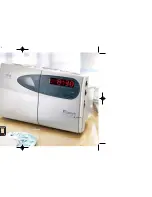
9
GENx192 Studio Master Clock
Clocks, Cables and Termination
Sample Clocks
Within each piece of digital audio equipment are one or more clocks
that control signal and timing relationships between various internal
components and external devices. The sample clock controls the A/D
and D/A conversion rate and timing of audio signal transfers through
digital interfaces such as AES, TDIF, and ADAT optical. The rate at
which this clock runs is known as the Sample Rate. The most common
‘standard’ sample rates used in professional audio are 44.1 kHz and 48
kHz, from which many other less common rates are derived.
To properly receive a digital signal transmitted from another device, the
sample clocks of both sending and receiving devices must precisely
match each other. To use an analogy, imagine a machine placing parts
onto a conveyor belt, while another machine picks the parts off the
other end of the belt and packages them. If both the first machine and
the belt are running at a constant rate, then the packaging machine
must also take the parts off the line at precisely the same rate. Not
only must the packaging macine run at the identical rate, it must also
pick the part off the belt at the exact moment the part passes it. If the
alignment is out of whack, then even though the packaging macine
runs at the correct speed, it will miss every part.
As everyone knows, if you take two wristwatches, set them to the exact
same time and start them at the same moment, a week later they will
not read the same time. The crystal oscillators used to generate the
sample clock inside each digital audio device are no different - no two
crystal oscillators run at exactly the same rate. Therefore they must
be synchronized externally using a common ‘master’ clock signal that
provides both frequency (rate) and position (alignment) information.
This master clock can be either any digital device in the system, or a
dedicated clock generator such as the GENx192. Most professional
audio equipment, including DAT machines, digital consoles, A/D and
D/A converters, and DAWs can slave their internal sample clock to
an external sample clock, unlike most consumer audio devices which
cannot (such as CD players with digital outputs).
Common Clocking Problems
Insuring proper system synchronization requires not only paying
attention to the software and/or hardware configuration of each device
in the system, but also using the correct interconnection hardware
(cabling, connectors, termination) and employing the appropriate
interconnection topology. Failing to do so may result in any one of a
number of common synchronization problems, some of which are not
readily perceptible or easy to diagnose.
Jitter:
Jitter refers to the amount of aperiodicity in a clock signal, and
is generally measured in ‘nanoseconds’ (ns or 10-9 s). For
example, a jitter-free 50 kHz clock has exactly one clock cycle
every 20µs (10-6 s). If the period of this clock changes from
19.997 µs to 20.001 µs from one moment to the next, then the
clock is said to have 4 ns of jitter because the period varies by
4ns.
Jitter degrades the quality of the analog-to-digital and
digital-to-analog conversion process by inducing harmonic
distortion into the signal, and therefore is hard to notice
without comparing it to an ideal (extremely low jitter) signal
within the same listening environment. Jitter can also ‘smear’
the sharpness of a stereo image created with phase-coherent
micing techniques (e.g. stereo-mic’d acoustic guitar). Because
jitter can be considered as a signal that modulates an ideal
clock, it also has a frequency spectrum which affects the
character of the distortion.
Jitter is the cumulative effect of numerous causes, ranging from
poor grounding to the characteristics of the internal circuitry
of the equipment itself (noisy power supplies, signal crosstalk,
circuit components, etc). While some of these factors cannot
be controlled, external factors such as cabling, termination, and
clock distribution method can play a significant contributing
role.
Drift:
Drift occurs when two or more audiovisual record/playback
systems (DAW, digital tape, video, etc.) do not share a common
master clock. The problem is a direct consequence of the
wristwatch illustration used above: when two DAWs are both
set to internal clocks at the same sample rate, and if they
contain identical audio material and are started at exactly the
same time, then over time one DAW will begin to play back
behind the other. Whereas it may take hours or days for two
wristwatches to drift from each other appreciably, in the digital
world it typically takes only seconds or minutes for noticeable
drift to accumulate. Drift is invariably caused by a failure to set
up the operating parameters of the equipment correctly or to
make the correct synchronization connections.
Pops, Clicks, Hash, and Distortion:
Pops and clicks occur when the
clocks between two digitally interconnected devices running at
different clock rates (for reasons stated above) move into and
out of alignment with each other. As misalignment occurs audio
data is ‘dropped’, creating a discontinuity in the audio data.
Similar to the beating of two closely tuned strings, these pops
and clicks occur at the same rate as the difference in speed
between the two clocks. If the clock rate difference is very
slight, then the clocks will undergo a protracted period wherein
data will be dropped, causing a long burst of noise or ‘hash’
instead. In its most extreme forms (when jitter becomes > 5 to
10% of the clock period), jitter can induce the same problems
except that the period and rate of popping and distortion will
be random.
Содержание GENx192
Страница 1: ...GENx192 Studio Master Clock User s Guide...
Страница 15: ...15 GENx192 Studio Master Clock...


































